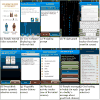Adaptive intervention design in mobile health: Intervention design and development in the Cell Phone Intervention for You trial
- PMID: 26229119
- PMCID: PMC4643384
- DOI: 10.1177/1740774515597222
Adaptive intervention design in mobile health: Intervention design and development in the Cell Phone Intervention for You trial
Abstract
Background/aims: The obesity epidemic has spread to young adults, and obesity is a significant risk factor for cardiovascular disease. The prominence and increasing functionality of mobile phones may provide an opportunity to deliver longitudinal and scalable weight management interventions in young adults. The aim of this article is to describe the design and development of the intervention tested in the Cell Phone Intervention for You study and to highlight the importance of adaptive intervention design that made it possible. The Cell Phone Intervention for You study was a National Heart, Lung, and Blood Institute-sponsored, controlled, 24-month randomized clinical trial comparing two active interventions to a usual-care control group. Participants were 365 overweight or obese (body mass index≥25 kg/m2) young adults.
Methods: Both active interventions were designed based on social cognitive theory and incorporated techniques for behavioral self-management and motivational enhancement. Initial intervention development occurred during a 1-year formative phase utilizing focus groups and iterative, participatory design. During the intervention testing, adaptive intervention design, where an intervention is updated or extended throughout a trial while assuring the delivery of exactly the same intervention to each cohort, was employed. The adaptive intervention design strategy distributed technical work and allowed introduction of novel components in phases intended to help promote and sustain participant engagement. Adaptive intervention design was made possible by exploiting the mobile phone's remote data capabilities so that adoption of particular application components could be continuously monitored and components subsequently added or updated remotely.
Results: The cell phone intervention was delivered almost entirely via cell phone and was always-present, proactive, and interactive-providing passive and active reminders, frequent opportunities for knowledge dissemination, and multiple tools for self-tracking and receiving tailored feedback. The intervention changed over 2 years to promote and sustain engagement. The personal coaching intervention, alternatively, was primarily personal coaching with trained coaches based on a proven intervention, enhanced with a mobile application, but where all interactions with the technology were participant-initiated.
Conclusion: The complexity and length of the technology-based randomized clinical trial created challenges in engagement and technology adaptation, which were generally discovered using novel remote monitoring technology and addressed using the adaptive intervention design. Investigators should plan to develop tools and procedures that explicitly support continuous remote monitoring of interventions to support adaptive intervention design in long-term, technology-based studies, as well as developing the interventions themselves.
Trial registration: ClinicalTrials.gov NCT01092364.
Keywords: Weight loss; adaptive clinical trial; intervention; lifestyle; mobile technology; weight maintenance.
© The Author(s) 2015.
Conflict of interest statement
The authors do not have any conflict of interest to report.
Figures
References
-
- CTIA. CTIA wireless industry indices. CTIA; 2014. US wireless quick facts.
-
- Pew Research internet project. Pew Research Center; 2014. Mobile technology fact sheet.
-
- Meeker M, Wu L. 2013 internet trends. Kleiner Perkins Caufield Byers. 2013
-
- Joo NS, Kim BT. Mobile phone short message service messaging for behaviour modification in a community-based weight control programme in Korea. J Telemed Telecare. 2007;13:416–420. - PubMed
Publication types
MeSH terms
Associated data
Grants and funding
LinkOut - more resources
Full Text Sources
Other Literature Sources
Medical



